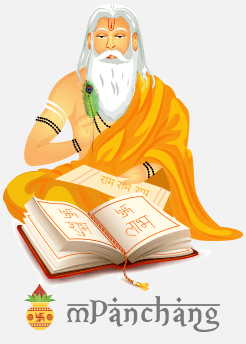Understanding Panchangam
What is a Panchangam?
Ideally, a Panchangam would be a detailed report of the day. It would include the Nakshatra (star) for the day, Tithi for the day, Yoga for the day and Karana during the day. Basically, it can be alternatively called as the mirror of the very sky, in paper and ink.
Since when has the system of Panchangam existed in our country?
For 5000 years, detailed records of Panchangam are available. There is a clear record that Panchangam were being widely used even then, as they are being used now.
From where did we come to know about the Panchangam?
You can know about Panchangam from two books specially.
1) Surya Siddhant
2) Grahalaghava
These two books form the basis behind all the calendars or Panchangas of the past used across different regions in the country. This is a complicated system culturally and the two books actually give way to two different theories that are used to compound the Panchangas.
How many parts does a Panchangam have?
Panchangas are also published in English and are known as Ephemeris.
There are basically five parts in a daily Panchang. Based on the motion of the Moon, a Panchangam is divided to incorporate
- Vaara (days of the week)
- Tithi (Hindu Lunar Day)
- Nakshatra (The starry constellations)
- Yoga (Auspicious and inauspicious period)
- Karana (Half phase of the Tithi)
Understanding the calculation of Time before understanding the formation of Panchangam
The primary importance is given to the way time is calculated in Vedic Astrology. Let us first try to understand time calculation according to Vedic Astrology.
The years together for a Samvatsara (a span of 60 years).
Each of the Zodiac signs is designated by the fixed years and has begun from Pramadi. The 60 years are divided equally amongst all the twelve signs (Rashis) beginning from Mesha (Aries) and ending with Meen (Pisces).
Know here daliy panchang for different locations of India.
The Varsha or the year is according to the Solar calendar and completes a full Zodiac cycle at the end of twelve months.
Apart from the solar calendar, there are two types of Lunar calendars.
1) The New Moon ending, that is called the Amanta or Sukladi system.
2) The Full Moon ending, that covers from one Full Moon to another and is called the Purnimanta system.
Each of the full Moon is known by the star that was present on Full Moon day of the solar month. The twelve Lunar months begin from Chaitra and the Solar Month and the Lunar Month are given accordingly,
|
1) Chaitra |
Chitra Nakshatra |
|
2) Vyshaka |
Vishakha Nakshatra |
|
3) Jyeshta |
Jyeshta Nakshatra |
|
4) Ashada |
Purvashad Nakshatra |
|
5) Shravana |
Sravana Nakshatra |
|
6) Bhadra |
Bhadrapada Nakshatra |
|
7) Ashwin |
Aswija Nakshatra |
|
8) Karthik |
Kartika Nakshatra |
|
9) Mrigashira |
Margashira Nakshatra |
|
10) Pushya |
Pushya Nakshatra |
|
11) Magha |
Makha |
|
12) Phalguna |
Uttaraphalguni |
The basic astrology is built around the various days of the week and this gave way to the Muhurats- the bad and the good moments during the day. Muhurat astrology or the astrology of elections was born out of this basic astrology pattern.
Another most important thing is the Tithi.
The Tithi can be defined as a lunar day, basically the time that is taken to increase the longitudinal angle between the Sun and Moon to increase by a movement of almost 12 degree.
The Tithi are spread from the first to the fourteenth each around the Shukla Paksh and the Krishna Paksh respectively totaling to 28 Tithi. There is an Amavasya and also a Poornima in between, raising the total Tithi to 30. The first Tithi is known as Pratipada and the fourteenth one is known as Chaturdashi.
Dagdha Rashi is nothing but the Rashis that is under the belt of Fire. These are the varied names of the Dagdha Rashis on each of the Tithi.
|
Name of the Tithis |
Dagdha Rashis |
|
Prathama |
Libra and Capricorn |
|
Dwitiya |
Sagittarius and Pisces |
|
Triteeya |
Leo and Capricorn |
|
Chaturthi |
Taurus and Aquarius |
|
Panchami |
Gemini and Virgo |
|
Shasthi |
Aries and Leo |
|
Sapthami |
Cancer and Sagittarius |
|
Ashtami |
Gemini and Virgo |
|
Navami |
Leo and Scorpio |
|
Dashami |
Leo and Scorpio |
|
Ekadashi |
Sagittarius and Pisces |
|
Dwadashi |
Libra and Capricorn |
|
Trayodashi |
Taurus and Leo |
|
Chaturdashi |
Pisces, Gemini, Virgo and Sagittarius |
|
Poornima |
None |
|
Amavasya |
None |
So, now that we have a brief idea of who is what, let us find out more about the Panchangam
The first thing that we would try to understand here is called,
Vaara: Vaara is the calculation of the days moving from one Sunrise to the next Sunrise. The system of calculation is known as Ahoratra, when both day and night are taken together.
Each of the seven planets comes forward and they take turns to form the order in which the days are organized.
The planet that governs the first Hora is known to define the nomenclature of the day. The Vara is ruled by Mars, the ruler of Fire element.
1) Saturn
2) Jupiter
3) Mars
4) Sun
5) Venus
6) Mercury
7) Moon
To understand better, we would try to see how each of these seven planets ruling the Sunday,
|
Every Hour |
Lords of the Hours |
|
First Hour |
Ravi |
|
Second Hour |
Shukra |
|
Third Hour |
Budha |
|
Fourth Hour |
Soma |
|
Fifth Hour |
Shani |
|
Sixth Hour |
Guru |
|
Seventh Hour |
Mangal |
|
Eighth Hour |
Ravi |
|
Ninth Hour |
Shukra |
|
Tenth Hour |
Budha |
|
Eleventh Hour |
Soma |
|
Twelfth Hour |
Shani |
|
Thirteenth Hour |
Guru |
|
Fourteenth Hour |
Mangal |
|
Fifteenth Hour |
Ravi |
|
Sixteenth Hour |
Shukra |
|
Seventeenth Hour |
Budha |
|
Eighteenth Hour |
Soma |
|
Nineteenth hour |
Shani |
|
Twentieth Hour |
Guru |
|
Twenty-first Hour |
Mangal |
|
Twenty-second Hour |
Ravi |
|
Twenty-Third Hour |
Shukra |
|
Twenty-Forth Hour |
Budha |
|
Twenty-Fifth Hour |
Soma |
So, if you see, Soma is the first hour of the next day, which is Monday.
Tithi: The Thirty Tithis are divided into five groups as given below. The Tithi is ruled by Venus, the ruler of the Water element.
- Nanda (meaning Joyous) includes the Pratipada (first), Shashti (sixth) and Ekadashi (eleventh) Tithi.
- Bhadra (meaning Healthy) and includes Dwitiya (second), Saptami (seventh) and Dwadashi (twelfth) day.
- Jaya (meaning victory) included the tritiya (third), Ashtami (8th) and Trayodashi (13th) basically on Tuesday.
- Rikkhta (meaning blank space or Loss) included Saturday and the Tithi of Chaturthi, Navami, Chaturdashi.
- Poorna (Full Moon Tithi) on Thursday and includes Panchami, Dashami, Amavasya or Purnima.
Nakshatra: Each Sub group has three stars and has a specific name. The name of these clusters of 27 Nakshatra are given below. The Lord of Nakshatra is Saturn, the ruler of the Air element.
The Nine Tara Groups are given below by their individual names:
- Janam Tara: The star present at the tenth position from the Janam Nakshatra and the 19th from the Janam Nakshatra is known as the Adhana Nakshatra. This Nakshatra comprises the Tara.
- Sampat Tara: The second, the eleventh and the twentieth Nakshatra from the Janam Nakshatra is known to constitute this Tara.
- Vipat Tara: The third, the 12th and the 21st stars from the Janam Nakshatra is this Tara.
- Kshema Tara: The 4th, 13th and the 22nd Nakshatra counted from the Janam Nakshatra are known to constitute this Tara.
- Pratyak Tara: The fifth, 14th and the 23rd from the Janam Nakshatra constitute this Tara.
- Sadhaka Tara: The 6th, 15th, and the 24th Nakshatra from the Janam Nakshatra.
- Nidhana Tara: The 7th, 16th and 25th Nakshatra from the Janam Nakshatra.
- Mitra Tara: The 8th, 17th and 26th Nakshatra from the Janam Nakshatra.
- Ati or Parama Tara: The 9th, 18th and 27th Nakshatra from the Janam Nakshatra.
Yoga: Now let us focus on understanding the Yoga system. The total number of Yogas completed is the sum of the total number of longitudes and latitudes crossed by them at any given time. It is the combination of Sun and Moon and is presided over by Jupiter, the ruler of the Akashi element.
Yoga = (Longitude of the Sun + Longitude of Moon) / 13 degree 20 inches.
There are 27 Yogas.
- Vishkabhma (Supported)
- Priti (Fondness)
- Ayushman (Long-lived)
- Saubhagya (Good fortune)
- Sobhana (Splendor)
- Atigandha (Danger or obstacles)
- Sukarma (Virtuous)
- Dhriti (Determination)
- Soola (Pain)
- Ganda (Danger or obstacles)
- Vriddhi (Growth)
- Dhruva (Constant)
- Vyagatha (Beating)
- Harshana (Thrill)
- Vajra (Thunderbolt)
- Siddhi (Success)
- Vyatipata (Calamity)
- Variyan (Comfort)
- Parigha (Obstruction)
- Siva (auspicious)
- Siddha (Accomplished)
- Sadhya (Amenable)
- Subha (Auspicious)
- Sukhla (Bright White)
- Bramha (Priest God)
- Indra (Chief)
- Vaidrithi (Poor Support)
There are 27 Nakshatra that are divided into 12 Zodiac signs and each Rashi has 2.5 Nakshatra.
Karana: Karana is usually considered half of one Tithi and each Tithi is thus divided into two equal parts. There are 11 kinds of Karana and they are again classified into two types- Movable Karana and Fixed Karana. Mercury is the ruler and is usually the ruler of the Earth element. Every Karana has diverse nature and out of all the Karanas the Bhadra period is considered to be extremely inauspicious. When a child is born in any particular Karana, their nature can be determined based on the nature of the Karana.
Each Tithi contains two Karanas and a 30-day month ideally has 60 Karanas. When we take the difference between the longitudes of the two illuminated planets, the Sun and the Moon and then divide it by 6, it is known as the Karana.
Movable Karanas include
Bava:
- Balava
- Kaulava
- Taitil
- Garaja
- Vanik
- Bhadra
Fixed Karanas are:
- Shakuni
- Chatushpada
- Naga
- Kimstugna
Details of each Karana is given below
|
Karana |
Nature |
Closest resembling Animal |
Karana’s State and Result |
|
Bava |
Movable |
Lion |
It is young age and is neutral in nature. |
|
Balava |
Movable |
Cheetah |
Latent/dormant karana and is the adolescent stage of Karana |
|
Kaulav |
Movable |
Pig |
It is facing upwards and is acropetal by nature. |
|
Taitil |
Movable |
Donkey |
Latent or dormant Karana and is inauspicious. |
|
Garaja |
Movable |
Elephant |
Latent and is the adulthood of humans. |
|
Vanik |
Movable |
Bull |
Latent and gives moderate results |
|
Bhadra |
Movable |
Owl/Hen |
Latent and gives moderate results |
|
Shakuni |
Fixed |
Bird |
Upward karana and offers normal results |
|
Chatushpada |
Fixed |
Dog |
Latent and offers normal results |
|
Nag |
Fixed |
Snake |
Latent and normal results |
|
Kimstughna |
Fixed |
Insect |
Latent and normal results |
To sum it up, we have to understand that the Panchang is the basis of our understanding of Astrology and it is at this very core of human existence where knowing the Panchang can make you understand more about a certain day. What is ahead of you, what makes you fall and what would be your strong points? When and which Nakshatra does well to you, which hour is favorable. Of course, it is difficult to keep on interpreting the Panchang every day or every hour, so if you want you can use the online services to understand where you stand ideally in terms of your daily Panchang.
Thus, understanding the Panchang would be ideal for our day to day living.


 ज्योतिषी से चैट करें
ज्योतिषी से चैट करें










Leave a Comment